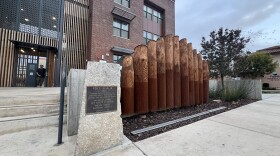It was a local innovation in school design that spread to campuses across California. It influenced generations of educators and students to this day. The story of the "finger plan" school design, today on KVPR's Central Valley Roots.
If you grew up in California and are of a certain age, there’s a good chance went to a public school that was designed in the “finger plan” style. It’s an odd name, but it describes a common theme that has seen many variations throughout the state.
Think long rows of single-story classrooms, all connected with common outdoor corridors. They almost always had north-facing windows, to bring in natural light and allow for fresh air with cross ventilation. The design was also easily expandable. So long as there was more land, all you had to do was add-on another classroom wing to deal with California’s growing student population.
It’s a concept that took off bigtime in the 1950s and 1960s in California, but it actually began here in the Central Valley. Bakersfield-born architect Ernest Kump Jr. invented the concept, with its first example being Fowler Grammar School in the small town of Fowler south of Fresno. Kump reportedly submitted the project as his masters thesis at Harvard University for his instructor, Bauhaus founder Walter Gropius. The concept soon spread to hundreds of schools across the state, and many of the buildings are still in use today, from Arvin to Visalia to Fresno.






